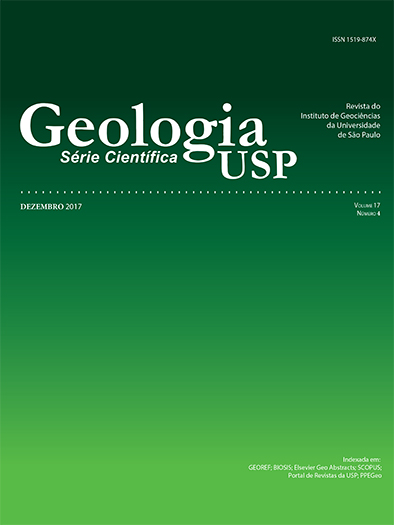Inorganic and organic geochemistry of the shales from Pimenteiras Formation: implications for an unconventional petroleum system
DOI:
https://doi.org/10.11606/issn.2316-9095.v17-131934Keywords:
Shale gas, Hydraulic fracturing, Macropores, Mineralogy, Clay minerals, Parnaíba Basin.Abstract
The Pimenteiras Formation records the marine ingression in the Meso/Neo-Devonian of the Parnaíba Basin, and it shales are the main source rock interval for its conventional petroleum system. The aim of this paper is to integrate geological and geochemical data in order to provide the potential on shale gas production of the Pimenteiras Formation, based on the outcrop sampling. Nine depositional facies were identified: shale with ostracods (Fo), micaceous silty-shale (Fm), tabular shale (F), massive fine or very fine sandstones (Af), sandstones with hummocky cross lamination (Ah), interbedded clay-silt couplets with linsen (Hl) and wavy (Hw) hetherolitics, dark siltstone with sulfide levels (S) and clast-supported breccias (Bc), observed on top of the outcrops. Clay minerals dominate the mineralogy, followed by quartz. Weathering processes are evidenced by the high contents of lateritic iron and kaolinite. The scanning electron microscopy allowed to classify the pores into macropores (> 50 μm), and also clusters of organic matter and clay minerals with various habits were seen, highlighting the massive and the vermicular ones. The total organic carbon (TOC) values range from 0.02 to 1.31%. Pyrite crystals occur in the rock with the highest TOC value in response to the anoxic behaviour of the S facies. Additionally, the composition of the clay minerals is dominated by smectites and mixed-layer clay minerals. The preliminary results indicate a prospective difficulty for the hydraulic fracturing due to the major presence of clay minerals. The primary porosity has favourable dimension, but unfavourable geometry. The low thermal maturity and inexpressive TOC values points out to the low potential production. Thus, the rocks of this study are unfavourable for the shale gas production under the current conditions required by the economic market.
Downloads
Downloads
Published
Issue
Section
License
Authors who publish in this journal shall comply with the following terms:
- Authors keep their copyright and grant to Geologia USP: Série Científica the right of first publication, with the paper under the Creative Commons BY-NC-SA license (summary of the license: https://creativecommons.org/licenses/by-nc-sa/4.0 | full text of the license: https://creativecommons.org/licenses/by-nc-sa/4.0/legalcode) that allows the non-commercial sharing of the paper and granting the proper copyrights of the first publication in this journal.
- Authors are authorized to take additional contracts separately, for non-exclusive distribution of the version of the paper published in this journal (publish in institutional repository or as a book chapter), granting the proper copyrights of first publication in this journal.
- Authors are allowed and encouraged to publish and distribute their paper online (in institutional repositories or their personal page) at any point before or during the editorial process, since this can generate productive changes as well as increase the impact and citation of the published paper (See The effect of Open Access and downloads on citation impact).





